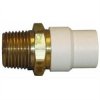Augusta
New Member
Contacted licensed plumbing company on Thursday last week around lunch to go ahead and swap out a hot water heater (from gas to electric on plumber's advice since I've had to replace the thermocouple 2 times on the existing Whirlpool...the class action law suit on them makes the part free, but labor ain't cheap). To speed things up, because I know how long Augusta Plumbers take to do the most remedial tasks with every excuse in the book, I disconnected the gas line and water lines from the existing gas water heater, delivered the new electric water heater and placed it next to gas water heater on the day before the Plumbers were given the go-ahead to do the swap out. There are no pipes to sweat, only a few lines to connect along with just connecting the newly run electrical line. Several days prior to Thursday, I had the Plumber's preferred Electrician run a line from the breaker box, that is within arm's length of the water heater you see in the picture, up through the attic and back down the wall.
Questions:
1. Why would the electrician put a junction box right there in the middle of the wall? I've only had to add a junction (I'm no electrician by any means) if I guessed the distance wrong and had to add to my run, and I only did that when I was running expensive copper wire over 150' in a crawl space up and out to a hot tub. This was the Electrician's response to my question, which made absolutely no sense at all: "He said there was no access to drill a hole via attic, so he had to run down the wall."
2. Wouldn't you say it would take a licensed Plumbing company, like, an hour to do the swap out? This house is a ranch, you could back your truck up to the front door, the laundry room is about 6 feet from the front door, and there are no step-ups/step-downs in the entire path.
Tomorrow makes one week that it's not done. The plumber has made 2 trips out so far. First they said that the Electrician didn't label the breaker, so they couldn't figure out which breaker went to the water heater - so they left. I asked if they had ever heard of a multi-meter, and that I was pretty sure even my mom could figure out which breaker went to the water heater. Below are the pictures I took a few hours ago. I mean honestly, is it just me, or is this task really that hard? Anything else you see that's not quite right? I depend on you guys because it really is that bad in Augusta.



Questions:
1. Why would the electrician put a junction box right there in the middle of the wall? I've only had to add a junction (I'm no electrician by any means) if I guessed the distance wrong and had to add to my run, and I only did that when I was running expensive copper wire over 150' in a crawl space up and out to a hot tub. This was the Electrician's response to my question, which made absolutely no sense at all: "He said there was no access to drill a hole via attic, so he had to run down the wall."
2. Wouldn't you say it would take a licensed Plumbing company, like, an hour to do the swap out? This house is a ranch, you could back your truck up to the front door, the laundry room is about 6 feet from the front door, and there are no step-ups/step-downs in the entire path.
Tomorrow makes one week that it's not done. The plumber has made 2 trips out so far. First they said that the Electrician didn't label the breaker, so they couldn't figure out which breaker went to the water heater - so they left. I asked if they had ever heard of a multi-meter, and that I was pretty sure even my mom could figure out which breaker went to the water heater. Below are the pictures I took a few hours ago. I mean honestly, is it just me, or is this task really that hard? Anything else you see that's not quite right? I depend on you guys because it really is that bad in Augusta.










